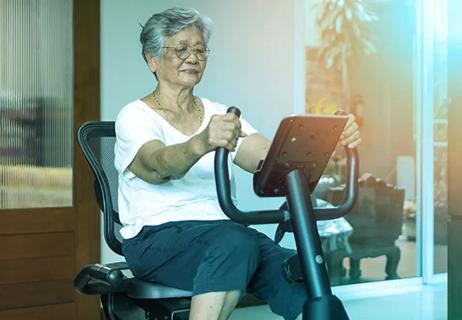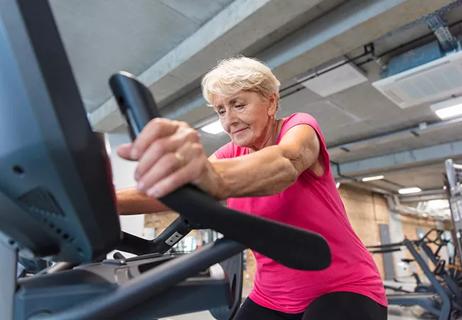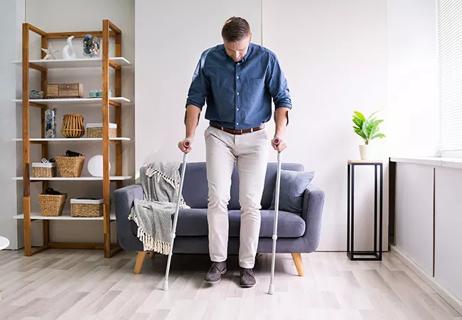Novel post-acute care model aims to improve functional outcomes with reduced costs

An innovative approach to deliver rehabilitation therapy at home instead of in specialized care facilities for patients following a stroke is getting a boost with a five-year Agency for Healthcare Research and Quality K01 grant to evaluate its effectiveness.
Advertisement
Cleveland Clinic is a non-profit academic medical center. Advertising on our site helps support our mission. We do not endorse non-Cleveland Clinic products or services. Policy
Developed by a multidisciplinary team at Cleveland Clinic, the “Home Care Plus” program, a model of high-intensity home-based rehabilitation (HIHR), includes physical and occupational therapy, nursing services and custodial services provided by aides from a contracted private agency. A previous pilot study in a broader group of post-acute care patients showed that outcomes compared favorably to those achieved during a 14-day stay in a skilled nursing facility.
The Home Care Plus model for patients with stroke is the result of efforts of an interdisciplinary team that has worked on its design and implementation since 2020, including the following Cleveland Clinic health system leaders: Dolora Wisco, MD, of the Neurological Institute; William Zafirau, MD, and Steven Pamer, PT, MPA, of the Center for Connected Care; Karen Green, DPT, of Rehabilitation and Sports Therapy; and Jessica Hohman, MD, MSc, of the Medicare Accountable Care Organization.
“We have narrowed the focus to stroke patients for the current project because rehabilitation is an evidence-based part of their care,” explains grant recipient Joshua Johnson, DPT, PhD, Director of Outcomes Research in Cleveland Clinic’s Department of Physical Medicine and Rehabilitation. “Discharge to an acute rehabilitation facility is typical, but most of these individuals would prefer a home-based program. With this study, we’re evaluating what is already being done within our health system to address that goal.”
Since the program’s implementation in October 2021, 23 stroke patients have been treated by Cleveland Clinic Home Care using the HIHR model, and Dr. Johnson says the initial results have been positive. “There have been no red flags, and we’re finding that patients are making pretty significant functional gains over the course of the care episode, based on the CARE Tool Section GG scores now required by Medicare,” he notes.
Advertisement
Stroke patients are eligible for HIHR if they have mild to moderate functional impairment, mild to moderate stroke-related symptoms, stable medical status, minimal skilled nursing needs and at least some caregiver support at home. The focus in HIHR is increasing therapy service intensity. Patients receive as many as 12 visits a week from rehabilitation professionals, versus the one to three that are typical for home care.
“Our goal is for the therapists, primarily, to be in the home more often so they can meet the needs they observe for these patients and their families,” Dr. Johnson says. “We are working to tailor care to the patient. If a patient’s main deficits pertain to speech, then a speech therapist is their primary provider, not an occupational or physical therapist.”
Of the 58 patients who completed the HIHR pilot program, which was rolled out in 2019, 97% improved in measures of functional independence. The average cost per HIHR episode was $3,400, versus roughly $6,720 for a 14-day stay in a skilled nursing facility.
The objectives of the project for which the K01 grant was awarded are threefold:
The Cleveland Clinic team also will be examining the impact of the new HIHR paradigm on costs of care. “Post-acute care has become a primary target for cost reduction in the U.S. healthcare system,” Dr. Johnson notes. “Our initial experience with home-based rehabilitation for stroke patients suggests that it may be 30% to 50% less costly than facility-based rehabilitation.”
Advertisement
The researchers anticipate that over a 12-month period, 30 to 40 stroke patients will be enrolled in the HIHR program. The control group, for purposes of comparison, will be similar patients receiving care in inpatient rehabilitation and skilled nursing facilities during the same time period. Both quantitative and qualitative outcomes will be assessed.
“We will talk to a select group of stroke patients and their primary home caregivers and ask about their experiences,” Dr. Johnson explains. “The aim is to better understand what we need to do differently to identify individuals for whom high-intensity home-based rehab is most appropriate.” Lessons learned from the initial stroke model then will be used to improve the HIHR program and potentially broaden its applicability to other types of patients.
Reflecting on the challenges of implementing HIHR and advice for other institutions contemplating a similar approach, Dr. Johnson identifies staffing as a major concern.
“Having enough appropriately trained rehabilitation specialists is key,” he says. “For that reason, our leaders in the Center for Connected Care have been very purposeful about hiring therapists with experience treating patients with significant functional deficits. For now, this care model is available only for patients discharged from select Cleveland Clinic hospitals. With the right team and for the right patients, high-intensity home-based rehabilitation can be a high-value substitute for facility-based care. This makes it likely to offer important benefits for the healthcare system.”
Advertisement
Advertisement

Group program offers adapted exercises and lifestyle education to individuals in need

Research to test clinical efficacy and cost-effectiveness versus standard-of-care rehab

Pilot study finds both forced- and voluntary-rate cycling effective for symptom management

Gait becomes more normalized along with gains in speed

Training in stretches, emphasis on biomechanics help ease work-related pain, survey finds

High-intensity cycling program leads to improved walking capacity and upper extremity function

More evidence needed on pharmacologic therapy alone and combined with gait training

Innovative postacute care model reduces costs, improves functional outcomes